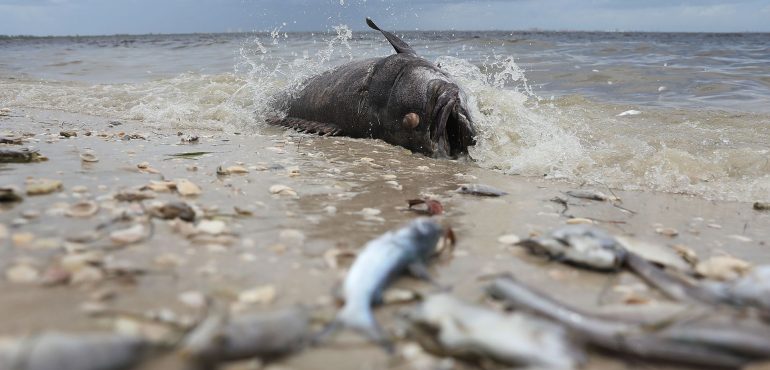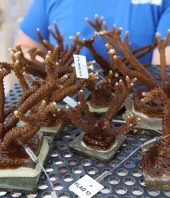We’re answering some of your biggest questions about red tide and its impact on Manatee County and Anna Maria Island.
What is red tide?
According to the Florida Fish and Wildlife Conservation Commission: “A red tide, or harmful algal bloom, is a higher-than-normal concentration of a microscopic algae (plantlike organism). In Florida and the Gulf of Mexico, the species that causes most red tides is Karenia brevis, often abbreviated as K. brevis. To distinguish K. brevis blooms from red tides caused by other species of algae, researchers in Florida call the former the ‘Florida red tide.’
Many red tides produce toxic chemicals, and the organism specific to Florida’s red tide has toxins that affect the central nervous system of fish, which kills them. Waves break open the organism cells and send them into the air, and that can affect humans’ respiratory systems, mostly just an irritation. Pets can also be affected, and the FWC suggests bringing them inside during blooms and not letting them swim in red tide waters or play with dead fish.
It’s not new: “Red tides were documented in the southern Gulf of Mexico as far back as the 1700s and along Florida’s Gulf coast in the 1840s,” according to FWC.
Mote Marine Laboratory and its partners have monitored for Florida red tide from October 2017 through July 2018.
What causes red tide?
Red tide is caused by the algae bloom. Its occurrence can’t be predicted, but scientists can forecast its movement, according to FWC.
Red tide needs three components to form a bloom. First the organism must be present in the water. Second is the correct chemistry — the nutrients that it needs to grow. Third is that physical conditions have to be right in order to concentrate and transport the microscopic algae, according to Mote Marine Laboratory.
What are the effects of red tide?
Red or brown-green water color, dead fish washed up onto the shore, odor of dead fish and respiratory irritation.
Those with underlying chronic respiratory problems such as asthma should avoid red tide areas, according to Mote. You can wear a mask to cover your nose and mouth if you notice you are experiencing symptoms.
Why is red tide harmful?
Red tide produces brevetoxins that can affect the central nervous system of fish and other vertebrates, often causing death, Mote researchers say. Waves can break open the organism’s cells and release those toxins into the air, leading to respiratory irritation.
Where is it?
Signs of red tide were spotted all along Anna Maria Island on Monday, as far north as the Rod ‘n’ Reel Pier.
It has also impacted beaches in Sarasota County and as far south as Collier County, according to FWC.
How long will it last?
The short answer is, we don’t know. Red tides can go on for a few weeks or longer than a year, according to researchers. How long a bloom will last depends on physical and biological conditions as well as the wind and water currents.
Blooms can also subside and reoccur.
Is it safe to swim?
According to the FWC, it’s safe for most people to swim, but definitely not around dead fish. There can be irritation to skin, eyes and the respiratory system. If someone swimming does experience signs of irritation from red tide, get out of the water and wash off.
Also, don’t allow your pets to play with dead fish or foam on the beach. Wash them as soon as possible if they happen to swim in red tide waters.
Are businesses closing?
None of the Anna Maria Island or Cortez businesses that the Bradenton Herald spoke with Saturday through Monday have closed.
What is being done?
As of now, there is no practical way to control or kill the blooms, according to FWC. Any potential control methods would have to kill the organism and get the toxins it produces out of the water without harming the environment. So far, nothing has worked.
Mote, however, is developing and assessing different technologies.
Is it the worst year?
It’s not necessarily the worst red tide event but it is one of the more prolonged events in several years, said FWC spokeswoman Melody Kilborn.
“We’ve been following it since November (2017),” Kilborn said, “and it has moved up and down the coast several times because of the wind and the current.”
Red tides are common and have been recorded by the FWC since the mid-1800s.
The first year that at least medium levels of red tide lasted a year or longer was in 1954, according to the FWC’S monitoring database.
The same occurred in 1996, 2003 and 2005. Several years in between had long bouts of red tide, often lasting at least 10 months.
The database will be updated with 2018’s ranking once the year concludes, officials said.
Does Lake Okeechobee factor in here?
According to FWC and Mote researchers, no.
In contrast to many red tide species that are fueled by nutrient pollution associated with urban or agricultural runoff, there is no direct link between that pollution and the frequency or severity of red tide caused by K. brevis, which is what we are seeing on southwest Florida beaches, according to both entities.
“There are two distinct algal blooms: One is the red tide, which is found off southwest Florida in the gulf, and the other is the blue-green algae found in freshwater,” Kilborn said.
Florida red tide, FWC and Mote researchers say, develops 10-40 miles offshore, away from man-made nutrient sources. Red tide can only survive in the ocean and is naturally occurring in the Gulf of Mexico, Kilborn said.
Red tides have also occurred in the state before human settlements and have been recorded since the 1800s. There were even severe red tides observed in the mid-1900s, Mote says, before Florida’s coastlines were heavily developed. However, once red tides are transported inshore, they are capable of using man-made nutrients for their growth, according to FWC officials.
However, other harmful algae, including cyanobacteria (blue-green algae), typically bloom in freshwater lakes and rivers, as they quickly die in saline waters, FWC officials said.
Persistent cyanobacteria blue-green algae is what has been forming in Lake Okeechobee and affecting rivers and canals on both sides of the state.
For more information on red tide, visit myFWC.org.research/redtide and Mote.org.
Source: Miami Herald, Full Article






